1.创建服务端:
1.新建aidl文件 ,并make project

AIDL 支持 的类型有:int long Boolean float double String
interface IMyAidlInterface {
/**
* Demonstrates some basic types that you can use as parameters
* and return values in AIDL.
*/
void basicTypes(int anInt, long aLong, boolean aBoolean, float aFloat,
double aDouble, String aString);
String getName();//自定义接口
}2.客户端创建 Service
在service里面创建一个内部类,继承刚才创建的AIDL的名称里的Stub类,并实现接口方法,在onBind返回内部类的实例。
public class MyService extends Service {
public MyService() {
}
@Override
public IBinder onBind(Intent intent) {
// TODO: Return the communication channel to the service.
return new MyBinder();//返回MyBinder类实例
}
//自定义内部类 并继承AIDL接口的STUB类 实现AIDL接口里的方法
class MyBinder extends IMyAidlInterface.Stub{
@Override
public void basicTypes(int anInt, long aLong, boolean aBoolean, float aFloat,
double aDouble, String aString) throws RemoteException {
}
@Override
public String getName() throws RemoteException {
return "name";
}
}
}3.给Service 设置action
<service
android:name=".MyService"
android:enabled="true"
android:exported="true">
<intent-filter>
<action android:name="com.example.aidl.MyService" />
</intent-filter>
</service>
2.创建客户端
1.复制服务端的AIDL包到客户端,并make project

2.绑定Service
protected IMyAidlInterface iMyAidlInterface;
Intent intent = new Intent("com.example.aidl.MyService");
intent.setPackage("com.example.aidl");
bindService(intent, new ServiceConnection() {
@Override
public void onServiceConnected(ComponentName name, IBinder service) {
iMyAidlInterface = IMyAidlInterface.Stub.asInterface(service);
}
@Override
public void onServiceDisconnected(ComponentName name) { }
},BIND_AUTO_CREATE);3.调用接口,获得数据
Toast.makeText(MainActivity.this, iMyAidlInterface.getName(), Toast.LENGTH_SHORT).show();
2.AIDL如何使用自定义类型
1.定义自定义类并实现Parcelable 接口
public class Person implements Parcelable {
int age;
String name;
protected Person(Parcel in) {
name = in.readString();
age = in.readInt();
}
public static final Creator<Person> CREATOR = new Creator<Person>() {
@Override
public Person createFromParcel(Parcel in) {
return new Person(in);
}
@Override
public Person[] newArray(int size) {
return new Person[size];
}
};
@Override
public int describeContents() {
return 0;
}
@Override
public void writeToParcel(Parcel dest, int flags) {
dest.writeString(name);
dest.writeInt(age);
}
}
2. 在 aidl文件中引用
parcelable Person;//必须引入 不然会报错
interface MyAidlInterface {
/**
* Demonstrates some basic types that you can use as parameters
* and return values in AIDL.
*/
void basicTypes(int anInt, long aLong, boolean aBoolean, float aFloat,
double aDouble, String aString);
String getName();
Person getPerson();//使用自定义类型
}3.将自定义类型和aidl接口 复制到客户端即可:注意 自定义类型的包名要和aidl里声明的包名一致,不然会报错(找不到类)
最后
以上就是称心棒棒糖最近收集整理的关于Android AIDL 的使用1.创建服务端: 2.创建客户端的全部内容,更多相关Android内容请搜索靠谱客的其他文章。
本图文内容来源于网友提供,作为学习参考使用,或来自网络收集整理,版权属于原作者所有。








发表评论 取消回复